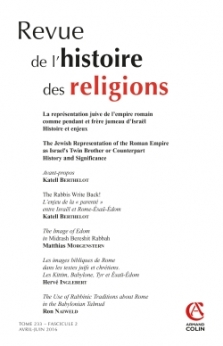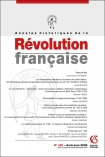
Revue de l'histoire des religions (2/2016)
Pour acheter ce numéro, contactez-nous
Recevez les numéros de l'année en cours et accédez à l'intégralité des articles en ligne.
Dans la littérature rabbinique, Ésaü (Édom), le frère de Jacob, est le personnage choisi pour incarner le rôle de Rome, l’empire mauvais. Dans ce contexte, cet article traite de l’image d’Édom dans le Midrash Bereshit Rabbah, une compilation d’interprétations rabbiniques et de commentaires haggadiques sur le livre biblique de la Genèse, rédigée par les Sages (rabbins) à la fin du ive siècle ou au début du ve siècle pour réfléchir sur les événements de leur époque. L’article montrera que, tout en utilisant des traditions plus anciennes, les rabbins rédacteurs de ce texte ont réalisé une composition cohérente, qui peut être expliquée par la perspective de leur temps, c’est-à-dire la christianisation de l’empire suite à la conversion de Constantin.
In Rabbinic literature, Esau (hence Edom), Jacob’s brother, is the character systematically chosen to incarnate the role of Rome, the “wicked empire,” both in the pagan (pre-Constantinian) and Christian periods. With this in mind, this article deals with the imagery of Edom in the classical Jewish Midrash Bereshit Rabbah, a compilation of Rabbinic interpretations and aggadic commentaries on the Biblical book of Genesis edited by Rabbinic sages during the late 4th or early 5th century C.E. in order to reflect upon the contemporary events of their time. It will be argued that the Rabbis who formed this text in its final stage merged older traditions and brought them into one coherent composition which may best be explained by the perspective of their time, after the Christianization of the Roman Empire.

